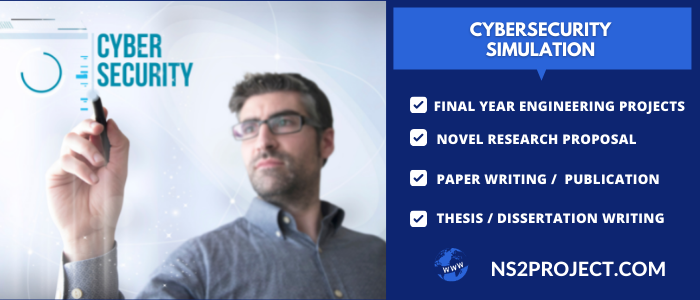Cybersecurity simulation is a process of recreating the process of securing the data from adversarial attacks like privacy violation of data or by using ransomware or malware. It also steals the user’s sensitive data. In the technology-based world, we use to share information through various network platforms across the globe. Many researchers use both physical and virtual types of networks that are expensive and time taking.
“One of the biggest challenges is to protect your data, and methods from securing data from thefts are on the way of developing!”
OVERVIEW OF CYBERSECURITY SIMULATION
Cybersecurity threats may lead to safeguarding the networks by network managers. To get protected from the threat, we must be familiar with the testbed (simulation /emulation) to find the amount of damage caused by such threats. Because having theoretical knowledge of interference techniques is not considered to be enough. Users who belong to all cyberspace might be under cyber-attack. Based on the necessity of the given topic, the simulation technology is particularly designed for developing cybersecurity to examine the data fusion system.
This article provides various simulation modeling methods like intrusion detection systems, tools for simulation, and further research ideas in cybersecurity simulation. We are glad to inform you that we will provide our support to the complete end of the cybersecurity simulation project.
Different Types of Cyber Attack Simulation
Considering an attack and different training scenarios, simulation can be used as,
- Virtual Simulation
- Actors: Real/ simulated or emulated
- Interacts with: real and isolated networks with emulated or simulated networks
- Constructive simulation
- Actors: simulated or emulated
- Interacts with: emulated or simulated networks
- Live simulation
- Actors: real
- Interacts with: real devices that are connected by physical mode
Important cybersecurity models
- Mechanism Model
- It is an analytical model running based on four types of integrated models as dynamic, multi agent and variable structure model.
- Probabilistic Model
- It is a Game Theory and Uncertainty based models
- Graphical Model
- It is used for modeling Network Attacks by means of State transition Diagram, Attack Graph, Attack tree etc. Further, it is also a finite state model based on Graph Theory.
The following probabilities are used to measure the threat’s success or failure rate when the above concepts are applied to cybersecurity. A successful attack is associated with loss and type of attack. The research sections covered the role of simulation in cybersecurity,
- Assessment and threat analysis
- Explore, test and assess
- Building environment of representative simulation
- Notifying and report generating
- Preparing and analyzing
How does cybersecurity simulation works?
The cybersecurity simulation modeling technology is in the beginning stage, which enables the users a daily basis alerting system of generating cyber-attacks. Based on the user’s specification, a simulation model can mimic the interfering detection system by alerting the effective cyber security attack simulation and harmless activities in a network. However, the user can modify the alerts into various scenarios. Such flexible simulation modeling enables the effective production of data to estimate to be conscious about the situation and provides calculating tools for cybersecurity.
Modeling a system that simulates the flow that processing packets potentially billion packets/day is possible, as it took a small fraction of packet to cause alert on the interruption detecting system. For the above process, a large amount of processing good packets simulation is required.
In the following, the Cybersecurity domain is discussed for the power system (smart grid technologies).
- In the first level, the performance of the power system will get affect and it considered as a failure in top level.
- In the second level, of the power system attack causes a sudden load drop and it occurs frequency imbalance, which is known as physical consequences.
- In the third level, the SCADA system refers the settings of the network by commanding the prime mover and exciter. It also demands side responding comments. This process is called as Cyber Attack.
- In the fourth level of the attacking technique in a system compromises the access to the data.
We are here to help you with an outline of our ideas to work with Cybersecurity simulation. Not only for power systems, we can also incorporate all of our research ideas and innovations in other research areas, including Networking, Cloud Computing, Mobile Computing, and Mobile Edge Computing Technologies, etc.
How do we work on Cyber-attack simulation?
- Give visualization for event simulation and auto-attack generation separately
- Listing the running services over the machine
- Analyzing the vulnerabilities in a model and choose the success of an exploit
- Permit more than two connectors to route with network traffic.
- Creating and saving multiple attack scenarios to be saved in a network
- Listing the procedures that are forbidden or permissible to analyzing the success of threats
Our developers suggest you some of the cybersecurity simulation tools that combine the features of hackers’ capacity and generate automated attacks. Further, automated penetration testing and vulnerabilities of the network can be simulated in the cybersecurity environment
How to choose the simulation tool for cybersecurity projects?
As we discussed earlier, simulation tools or software must be chosen by the functioning of the cybersecurity dissertation model/framework. In particular, the simulator must consist of appropriate modules, libraries, plugins, and header files for the given concept. Further, cyber security-based simulation tools must contain the following features to obtain a good simulation result.
- Able to differentiate the normal / malicious attackers
- Capacity to Use 100’s of features / attributes in the dataset
- Allow large volume of both static and dynamic dataset
- Analyze and show the results of network vulnerabilities
Such available simulation tools for cybersecurity models are given below.
- GTNetS
- NS-2
- NS-3
- SWANS / JIST
- SSFNet
- INET Framework with OMNeT++
From the above, we detailed here the OMNET++ simulator for cybersecurity projects. Let’s see below to view more information.
OMNET++ (NETA framework)
- NETA is basically a security tool in security. Attacking NETA is a framework designed to mimic attacks in a mixed networks using OMNeT++ and INET-framework. It can easily compare the capacity of various defense methods along with its outcomes
OMNET++ (SEA framework)
This simulator aids the user in evaluating the effect of security attacks. It matches with outdated, network-based structures (like SDN). The recently released version is as follows,
- Python 2.7.6 interpreter
- C++11 compiler
- OMNeT++ 4.x based INET 2.6
- The libxml library
In the process of OMNeT++, SEA framework includes a normal network topology of UDP server, and an Ethernet switch associates two users. This action describes how to,
- Use the simulation to estimate the attack’s effect
- Express SEA++ components presented network situations
- Explaining the ASL for attacks
OMETT++ (SCADASim)
It is used as a simulation tool used in Supervisory Control and Data Acquisition systems to check the impact of attacks.
Node Input Parameters
This parameter includes three primitives, such as disable, destroy and move, which are discussed below.
- Disable primitive
- Define: (nodelD, t)
- Functions: Makes the node entirely defective by removing the node from simulation running by time t.
- Destroy primitive
- Define (nodeID, t)
- Functions: After resolving the issues, detaching all network packets, and then it come to an end for application executions.
- Move primitive
- Define: (nodelD, t, x, y, z)
- Functions: Modify the position of nodelD from the old position to the new position by three dimensional in time t.
Packet input parameters
- Change (packet, field, new content…)
- The changing primitive tails the creating action as it changes the existing content in a packet with new content.
- Create (packet, field, content…)
- A single creates the new packet that can particularize multiple fields’ of content.
- Retrieve (packet, field, variable)
- Retrieving parameter allots variable by regaining the field value of a packet.
- Clone (SrcPacket, dstPacktet)
- The cloning parameter imitates or copies the SrcPacket into dstPacktet.
- Put (packet, updateStats, recipientNodes, direction, forwardingDElay)
- Positioning parameter passes through communication channel for put the packets into either transmission or the reception.
- Send (packet, forwardingDelay)
- Sending parameter creates a lowest layer of delay forwarding by programming the spread of selected packet.
- Drop (packet)
- Dropping process initiated to rejects the packet
Attackers Simulation Parameters
The attacker’s parameters are different based on their intention. Due to that, we specified here the number of input parameters taken for the simulation.
- Time of arrival
- Number of attackers
- Configuring jammers
- Number of transmitted bytes
- The network that attacked
- Hopping time of frequency, their position
- Simulation time of the attackers and their position, size and rate of the packet
- Behavior of the attackers and their intensity in percentage
The following functions are executed for cybersecurity simulation:
- Threat reporting tool permits the user to examine the results of various chain actions
- Network topology explained with security testing results representing by a Topology Visualization Module
- Giving information about the recognized attacks through security reporting
Datasets used for Cyber security simulation
- UNSW-NB15
- Attack Types: 9
- Data Type: Pcap files
- No of IP Address (Distinct): 45
- No of Networks: 3
- Feature Extraction: New Tools, Bro-IDS and Argus
- Extracted Features: 49
- KDDCUP99
- Attack Types: 4
- Data Type: 2
- No of IP Address (Distinct): 11
- No of Networks: 2
- Feature Extraction: Bro-IDS tool
- Extracted Features: 42
- IRAD
- Attack Types: 3
- Data Type: Pcap files
- No of IP Address (Distinct): 4520
- No of Networks: 16
- Feature Extraction: Own Feature Extraction
- Extracted Features: 18
FUTURE DIRECTION OF CYBER SECURITY SIMULATION
Working with us will advance your future research, and here three major possibilities are discussed as
- Improving the behavior of models in simulation
- Development of access and data collection
- Producing recent theoretical concepts
Our expert research team will provide you complete support and guidance in all parts of the research to gain the expected research cyber security thesis outcomes. So we gratefully insist you grab the opportunity to work with us. Also, we extend our support in other cybersecurity simulation if you are interested.









